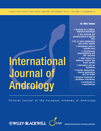Obstruction of the tubuli recti and ductuli efferentes by dilated veins in the testes of men with varicocele and its possible role in causing atrophy of the seminiferous tubules
Abstract
Hormone measurements, spermiograms and testicular biopsies studies were performed in young with varicocele. In addition, the testes and epididymides of 27 adults with varicocele were obtained from autopsies. Light and electron microscopic examination of biopsy and autopsy specimens revealed two types of lesions in testes with varicocele: 1) a diffuse lesion consisting of abnormal spermatozoa and spermatid morphology and sloughing of immature spermatozoa and spermatid: 2) focal lesion, distributed irregularly throughout the testicular parenchyma, affecting several small groups of seminiferous tubules. Each of these groups corresponded to a testicular lobule and showed different degrees of tubular atrophy, so that the focal lesions were distributed in a mosaic pattern. The testicular interstitium showed dilated veins and venules, and progressive collagenization. Some testes showed dilated veins in the rete testis, which compressed several tubuli recti and caused tubular atrophy in the seminifeous tubules opening into these tubuli recti. Other testes showed dilated young veins among the ductuli efferentes, and the rete testis channels appeared to be dilated. Among the different etiological mechanisms which have been suggested to for testicular lesions in varicocele. tubular obstruction at the level of either the tubuli recti or the ductuli efferentes might be responsible for lesions leading to testicular atrophy.




